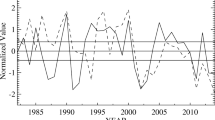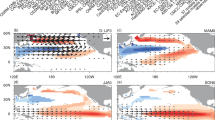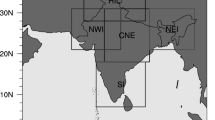Abstract
In recent years, the winter surface air temperature (SAT) anomaly over North American midlatitudes shows a “warm west/cold east” (WWCE) dipole pattern with warm (cold) extremes occurring in the west (east) of North America. In this paper, the Pacific sea surface temperature (SST) condition linked to the WWCE SAT dipole is investigated. It is found that the winter WWCE dipole can be crudely considered as being a result of the winter mean of sub-seasonal WWCE events. While the sub-seasonal WWCE dipole is related to the positive Pacific North American pattern (PNA+), the impact of the PNA+ on the WWCE dipole depends on the different type of El Niño SST pattern and the phase of Pacific decadal Oscillation (PDO). For a Central-Pacific (CP) type El Niño, the positive (negative) height anomaly center of PNA+ is located in the western (eastern) North America to cause a strong WWCE dipole, though the positive PDO favors the WWCE dipole. In contrast, the WWCE dipole is suppressed under an Eastern-Pacific (EP) type El Niño because the anticyclonic anomaly of the PNA+ dominates the whole North America. Moreover, the physical cause of why different types of El Niño influence PNA+ is further examined. It is found that different types of El Niño can significantly influence the midlatitude location of PNA+ through changing North Pacific midlatitude westerly winds due to changes in the Pacific Hadley cell. For the CP-type El Niño, the eastward migration of PNA+ is suppressed to favor its anticyclonic (cyclonic) anomaly appearing in the western (eastern) North America due to reduced midlatitude westerly winds via weakened Pacific Hadley cell. But for the EP-type El Niño, midlatitude westerly wind is intensified to cause the midlatitude anticyclonic anomaly of the PNA+ appearing over the whole North America due to enhanced Pacific Hadley cell.











Similar content being viewed by others
References
Baxter S, Nigam S (2015) Key role of the North Pacific Oscillation-West Pacific pattern in generating the extreme 2013/14 North American winter. J Clim 28(20):8109–8117. https://doi.org/10.1175/jcli-d-14-00726.1
Champagne O, Pohl B, McKenzie S, Buoncristiani JF, Bernard E, Joly D, Tolle F (2019) Atmospheric circulation modulates the spatial variability of temperature in the Atlantic–Arctic region. Int J Climatol 39(8):3619–3638. https://doi.org/10.1002/joc.6044
Chen X, Luo D (2017) Arctic sea ice decline and continental cold anomalies: upstream and downstream effects of Greenland blocking. Geophys Res Lett 44(7):3411–3419. https://doi.org/10.1002/2016gl072387
Chen X, Luo D (2019) Winter midlatitude cold anomalies linked to north Atlantic Sea Ice and SST anomalies: the pivotal role of the potential vorticity gradient. J Clim 32(13):3957–3981. https://doi.org/10.1175/jcli-d-18-0504.1
Chien YT, Wang SYS, Chikamoto Y, Voelker SL, Meyer JDD, Yoon JH (2019) North American winter dipole: observed and simulated changes in circulations. Atmosphere 10(12):15. https://doi.org/10.3390/atmos10120793
Ding R, Li J, Tseng Y-H, Sun C, Guo Y (2015) The Victoria mode in the North Pacific linking extratropical sea level pressure variations to ENSO. J Geophys Res Atmos 120(1):27–45. https://doi.org/10.1002/2014JD022221
Feldstein SB (2002) Fundamental mechanisms of the growth and decay of the PNA teleconnection pattern. Q J R Meteorol Soc 128(581):775–796. https://doi.org/10.1256/0035900021643683
Feng J, Li J (2013) Contrasting impacts of two types of ENSO on the boreal spring Hadley circulation. J Clim 26(13):4773–4789. https://doi.org/10.1175/jcli-d-12-00298.1
Feng J, Chen W, Li Y (2017) Asymmetry of the winter extra-tropical teleconnections in the Northern Hemisphere associated with two types of ENSO. Clim Dyn 48(7):2135–2151. https://doi.org/10.1007/s00382-016-3196-2
Ferranti L, Corti S, Janousek M (2015) Flow-dependent verification of the ECMWF ensemble over the Euro-Atlantic sector. Q J R Meteorol Soc 141(688):916–924. https://doi.org/10.1002/qj.2411
Franzke C, Feldstein SB, Lee S (2011) Synoptic analysis of the Pacific-North American teleconnection pattern. Q J R Meteorol Soc 137(655):329–346. https://doi.org/10.1002/qj.768
Harnik N, Messori G, Caballero R, Feldstein SB (2016) The Circumglobal North American wave pattern and its relation to cold events in eastern North America. Geophys Res Lett 43(20):11015–11023. https://doi.org/10.1002/2016gl070760
Hartmann DL (2015) Pacific sea surface temperature and the winter of 2014. Geophys Res Lett 42(6):1894–1902. https://doi.org/10.1002/2015gl063083
Kalnay E et al (1996) The NCEP/NCAR 40-year reanalysis project. Bull Am Meteorol Soc 77(3):437–471. https://doi.org/10.1175/1520-0477(1996)077%3c0437:Tnyrp%3e2.0.Co;2
Kao H-Y, Yu J-Y (2009) Contrasting Eastern-Pacific and Central-Pacific types of ENSO. J Clim 22(3):615–632. https://doi.org/10.1175/2008jcli2309.1
Kug J-S, Jin F-F, An S-I (2009) Two types of El Niño events: cold tongue El Niño and warm pool El Niño. J Clim 22(6):1499–1515. https://doi.org/10.1175/2008jcli2624.1
Lee T, McPhaden MJ (2010) Increasing intensity of El Niño in the central-equatorial Pacific. Geophys Res Lett 37:L14603. https://doi.org/10.1029/2010gl044007
Lee M-Y, Hong C-C, Hsu H-H (2015) Compounding effects of warm sea surface temperature and reduced sea ice on the extreme circulation over the extratropical North Pacific and North America during the 2013–2014 boreal winter. Geophys Res Lett 42(5):1612–1618. https://doi.org/10.1002/2014gl062956
Luo B, Luo D, Dai A, Simmonds I, Wu L (2020a) Combined influences on North American winter air temperature variability from North Pacific blocking and the North Atlantic Oscillation: subseasonal and interannual time scales. J Clim 33(16):7101–7123. https://doi.org/10.1175/jcli-d-19-0327.1
Luo D, Ge Y, Zhang W, Dai A (2020b) A unified nonlinear multiscale interaction model of Pacific-North American teleconnection patterns. J Atmos Sci 77(4):1387–1414. https://doi.org/10.1175/jas-d-19-0312.1
Michelangeli PA, Vautard R, Legras B (1995) Weather regimes—recurrence and quasi stationarity. J Atmos Sci 52(8):1237–1256. https://doi.org/10.1175/1520-0469(1995)052%3c1237:Wrraqs%3e2.0.Co;2
Peng P, Kumar A, Jha B (2014) Climate mean, variability and dominant patterns of the Northern Hemisphere wintertime mean atmospheric circulation in the NCEP CFSv2. Clim Dyn 42(9–10):2783–2799. https://doi.org/10.1007/s00382-014-2116-6
Peng P, Kumar A, Hu Z-Z (2018) What drove the Pacific and North America climate anomalies in winter 2014/15? Clim Dyn 51(7–8):2667–2679. https://doi.org/10.1007/s00382-017-4035-9
Peng P, Kumar A, Chen M, Hu Z-Z, Jha B (2019) Was the North American extreme climate in winter 2013/14 a SST forced response? Clim Dyn 52(5–6):3099–3110. https://doi.org/10.1007/s00382-018-4314-0
Rayner NA, Parker DE, Horton EB, Folland CK, Alexander LV, Rowell DP, Kent EC, Kaplan A (2003) Global analyses of sea surface temperature, sea ice, and night marine air temperature since the late nineteenth century. J Geophys Res Atmos 108(D14):4407. https://doi.org/10.1029/2002jd002670
Sardeshmukh PD, Hoskins BJ (1988) The generation of global rotation flow by steady idealized tropical divergence. J Atmos Sci 45:1228–1251
Schulte JA, Lee S (2017) Strengthening North Pacific influences on United States temperature variability. Sci Rep. https://doi.org/10.1038/s41598-017-00175-y
Seager R, Henderson N (2016) On the role of tropical ocean forcing of the persistent North American west coast ridge of winter 2013/14. J Clim 29(22):8027–8049. https://doi.org/10.1175/jcli-d-16-0145.1
Singh D, Swain DL, Mankin JS, Horton DE, Thomas LN, Rajaratnam B, Diffenbaugh NS (2016) Recent amplification of the North American winter temperature dipole. J Gerontol Ser A Biol Med Sci 121(17):9911–9928. https://doi.org/10.1002/2016jd025116
Straus DM, Shukla J (2002) Does ENSO force the PNA? J Clim 15(17):2340–2358. https://doi.org/10.1175/1520-0442(2002)015%3c2340:Deftp%3e2.0.Co;2
Wang C (2004) ENSO, Atlantic climate variability, and the Walker and Hadley circulations. Adv Global Change Res. https://doi.org/10.1007/978-1-4020-2944-87
Wang H, Pan Y, Kumar A, Wang W (2013) Modulation of convectively coupled Kelvin wave activity in the tropical Pacific by ENSO. Acta Meteorol Sin 27(3):295–307. https://doi.org/10.1007/s13351-013-0306-5
Wang S-YS, Hipps L, Gillies RR, Yoon J-H (2014) Probable causes of the abnormal ridge accompanying the 2013–2014 California drought: ENSO precursor and anthropogenic warming footprint. Geophys Res Lett 41(9):3220–3226. https://doi.org/10.1002/2014gl059748
Wang S-YS, Huang W-R, Yoon J-H (2015) The North American winter “dipole” and extremes activity: a CMIP5 assessment. Atmos Sci Lett 16(3):338–345. https://doi.org/10.1002/asl2.565
Wang S-YS, Yoon J-H, Becker E, Gillies R (2017) California from drought to deluge. Nat Clim Change 7(7):465–468. https://doi.org/10.1038/nclimate3330
Xie J, Zhang M (2017) Role of internal atmospheric variability in the 2015 extreme winter climate over the North American continent. Geophys Res Lett 44(5):2464–2471. https://doi.org/10.1002/2017gl072772
Yu B, Lin H (2018) Modification of the wintertime Pacific-North American pattern related North American climate anomalies by the Asian-Bering-North American teleconnection. Clim Dyn 53(1–2):313–328. https://doi.org/10.1007/s00382-018-4586-4
Yu B, Zhang X (2015) A physical analysis of the severe 2013/2014 cold winter in North America. J Gerontol Ser A Biol Med Sci 120(19):10149–10165. https://doi.org/10.1002/2015jd023116
Yu J-Y, Lu M-M, Kim ST (2012a) A change in the relationship between tropical central Pacific SST variability and the extratropical atmosphere around 1990. Environ Res Lett 7(3):034025. https://doi.org/10.1088/1748-9326/7/3/034025
Yu J-Y, Zou Y, Kim ST, Lee T (2012b) The changing impact of El Niño on US winter temperatures. Geophys Res Lett. https://doi.org/10.1029/2012gl052483
Yu B, Lin H, Wu ZW, Merryfield WJ (2016) Relationship between North American winter temperature and large-scale atmospheric circulation anomalies and its decadal variation. Environ Res Lett. https://doi.org/10.1088/1748-9326/11/7/074001
Yu B, Lin H, Wu ZW, Merryfield WJ (2017) The Asian-Bering-North American teleconnection: seasonality, maintenance, and climate impact on North America. Clim Dyn 50(5–6):2023–2038. https://doi.org/10.1007/s00382-017-3734-6
Acknowledgements
This research was supported by the National Natural Science Foundation of China (Grant numbers: 42150204) and Chinese Academy of Sciences Strategic Priority Research Program (Grant XDA19070403).
Author information
Authors and Affiliations
Corresponding author
Additional information
Publisher's Note
Springer Nature remains neutral with regard to jurisdictional claims in published maps and institutional affiliations.
Supplementary Information
Below is the link to the electronic supplementary material.
Rights and permissions
About this article
Cite this article
Ge, Y., Luo, D. Impacts of the different types of El Niño and PDO on the winter sub-seasonal North American zonal temperature dipole via the variability of positive PNA events. Clim Dyn 60, 1397–1413 (2023). https://doi.org/10.1007/s00382-022-06393-z
Received:
Accepted:
Published:
Issue Date:
DOI: https://doi.org/10.1007/s00382-022-06393-z




